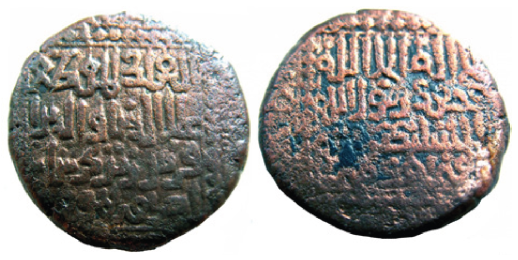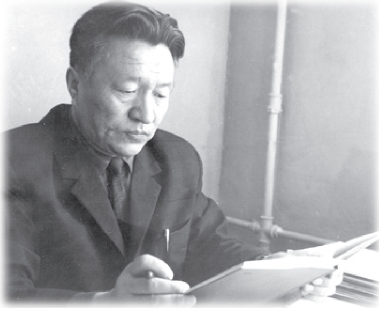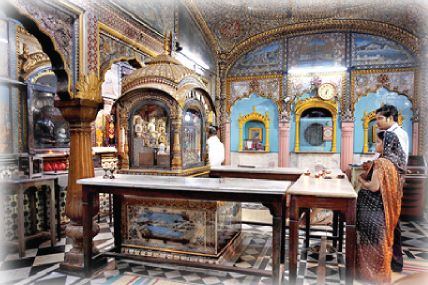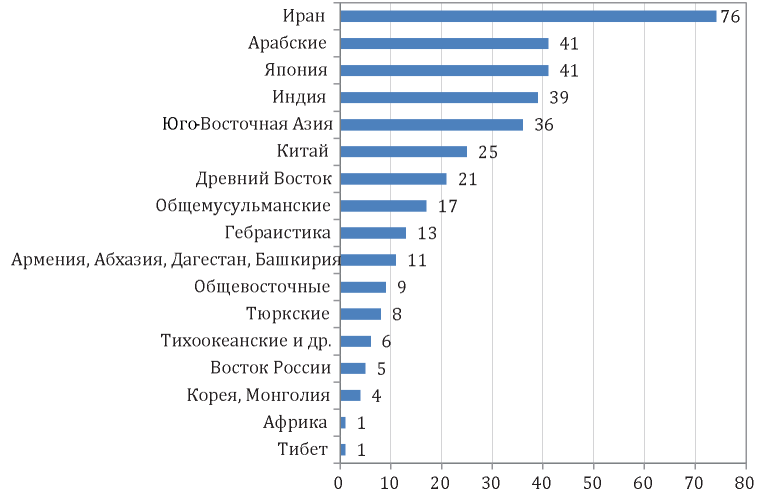FROM THE EDITOR 
HISTORY OF THE EAST. Historiography, source critical studies, historical research methods 
The authors publish two unique copper coins of the thirteenth century struck in the State of Shirvanshahs and in the Avar Nutsal with multiple die stamps. This kind of coins until recently has been known only among the Georgian medieval coins. The authors therefore offer a separate research regarding the origin of these rare items. They have discovered that during the period of the so called “silver famine” (in the Islamic world in 11th-12th cent.) production of multiple denominations did find an explanation from the point of view of the then economical situation.
HISTORY OF THE EAST. Universal history 
While researching the lokayata school of Indian philosophy are usually based on medieval sources. The author, however, did manage to discover two ancient references to the lokayata school. The first one are fragmentary mentions from the 'Arthashastra”; the second, is a detailed one from the sutras "Digha-Nikaya”. The result of comparison of these two sources is quite contradictory to what was commonly believed before, namely that the adherents of the lokayata were neither atheists and nor materialists. On the contrary, they were brahmanas-ritualists, zealous admirers of the "three Vedas”, fierce adherents of the "Dharma of the four varnas and ashrams” and related brahminic privileges. Besides, a comparison of the Canon (i.e. the list of recognized and studied disciplines-v/dya of the lokayata listed in the “Digha-Nikaya”) with the similar list ofthe brahminic “schools ofKautilya” (which comprises the “Arthashastra”) reveals almost complete identity. The findings suggest that the teaching of the “school of Kautilya” was similar to that of the lokayata school or was its variant.
The article deals with the Ayurvedic treatises about the importance of regular physical exercises for keeping good health. It offers translation from Sanskrit into Russian of some excerpts from the medical works of the classical period. Among them are the «Astanga-hrdayam» (about the 7th century AD), «Caraka-samhita» (2nd century BC - about the 1-2nd century AD), «Susruta-samhita» (3rd century BC -about 5th century AD) accompanied by the translations from the relevant traditional Sanskrit commentaries, such as «Sarvanga-sundara» by Arunadatta, «Ayurveda-rasayana» by Hemadri, «Sasilekha» by Indu, «Ayurveda-dipika» by Cakrapani, «Jalpa-kalpataru» by Gangadhara, «Nibandha-sangraha» by Dalhana.
HISTORY OF SCIENCE. Oriental Studies 
The publication presents the epistolary heritage of the prominent Russian Tibetologists, Doctor of History Regbi Pubaev (1928-1991), and the Tibetan language lecturer at the Faculty of Oriental Studies of the Leningrad State University, Ph. D. Bronislav Kuznetsov (1931-1985). Their correspondence presents an interesting slice of history of Tibetan Studies in the USSR in 1967-1984. The main content of the letters are important issues of the Tibetan Studies and an academic and teaching life of the scholars and friends. The publication is provided with an introduction, representing Pubaev and Kuznetsov, and comments.
PHILOSOPHY OF THE EAST. Philosophy of religion and religious studies 
The article discusses the phenomenon of the temple ritual worship (puja) of the most important characters in Digambara traditions of Jainism - the five “best”-paramesthins and different deities - patrons of places, doctrine etc. The author analyses both tangible and intangible forms of such veneration in their historical context, emphasizing that “material” form of the offerings and the worship of the material-embodied objects are the main soteriological goals - to overcome all physical and material aspects of human being.
This is a continuation of the translation into Russian of the Kitab al-Isharat wa-t-Tanbihat (The Book of Directives and Remarks) by Abu Ali Ibn Sina (Avicenna 980-1037). The Chapters 7 and 8 are closely related and comprise a discussion regarding the God's knowledge of particulars, providence and theodicy, the immortality of the soul and its otherworldly destiny.
The author offers a research of the philosophy of Indian poet, writer and thinker Rabindranath Tagore based on hermeneutical analysis of his book “The Religion of Man”. In terms of phenomenological approach the philosophy of the Indian thinker is described as a combination of spiritual experience in contemplation the Supreme Being, the freedom as a methodological approach, the tradition as the source of thought as well as the proof for the correctness of ideas, which is appropriate to Tagore. Having put himself within the tradition of Vedic rishis’ contemplation, the poet developed his own philosophy (ontology and anthropology). The philosophy of Tagore's religious humanism can be described as a synthesis of freedom of thinking and various Indian unorthodox philosophical traditions. The key idea of Tagore's ontology is jīvan-devatā ('the Lord of life’) the eternal Personality and Supreme Man, the Creator of the Universe and human beings. The phenomenon of a human being is the pivotal point in the development of the universe because he is considered there as an expression of the Truth and the Meaning of a life. The Tagore’s philosophy in this respect is far from the traditional Indian understanding of the phenomenon of a human being. Along with the teaching about the links of human soul to the Brahman (jīvan-devatā), the human as the result of Creation is being considered as His co-creator in the World and the Life, the main figure in evolution, the maker of Civilization and the Creator of culture. Man is understood as free, future-oriented and creative being. Tagore affirms for India the idea of value of human freedom, dignity and his earthly life not only for spiritual liberation (mukti), but for other people, society and culture.
LITERATURE OF THE EAST. Literature of the peoples of foreign countries 
The idea of nafs (literally arab. soul; self) is on the list of the key Sufi concepts; the term assumed importance both in doctrine and in the stories of the saints or the “God’s friends” (awliya), who were always in struggle with their carnal souls and never persevered in attempts to tame the recalcitrant nafs. The first part of the paper gives a brief overview of the meaning of the term nafs (from the Quran to Sufi teachings) and traces the stage by stage development of the “carnal soul” connotation; the variety of the translations is also under discussion. The second part centres around the uses of the term in 'Attar’s compendium Tazkirat al awliya (Memorial of God’s Friends). The narrative there is permeated with episodes of self-restraint; the descriptions of a Saint’s struggle with his own self (nafs) or his carnal soul (nafs) constitute a specific theme cluster of the hagiographic narration. 'Attar mostly translated the stories from the Arab sources, however he arranged them following the Iranian didactic tradition. Under his pen nafs has become a narrative personage, a devious and perfidious character more powerful than Iblis himself.
The author discusses the concept and relations between the ideas of nafs, jan, xvadl, and bl-xvadl as found in poems by the Persian Sufi poet Farid al-Din Attar (12th-13th Cent. AD) and offers their translation into Russian.
LITERATURE OF THE EAST. Theory of literature. Textology 
The article offers a set of criteria aimed for the reconstruction of the events of the history of ancient Israel. The author argues that these criteria might help the researchers to work out a balanced approach and help to avoid extremities of both “fundamentalist” and “hypercritical” approach (in the first instance, the Biblical texts are considered to preserve the historically true information whereas in the second instance the information preserved in the Biblical texts is rejected as a priori false). Every kind of reconstruction offers a kind of approximation, however, not the “truth”. Therefore, all available data should be put in a broad context and all the reasonable interpretation made on their basis, should be taken into account. One-sided approach like with archeological data, which may totally overwhelm the research results must be avoided. In this context it is crucial to understand how exactly and to which extent the Biblical texts can be trusted. Here, narrative analysis criteria can be of some help: the highest degree of historical reliability can be expected in the presentation of events, which offer the author most difficulties in their description. At the same time the level of his personal involvement in the events described can show how close he could be to the time, when the event was witnessed by others. The ways and methods of applying these criteria to the critical interpretation of the history of ancient Israel are illustrated in the article on a number of examples.
CHRONICLE. Conference report 
The article offers a summary of the results and discoveries by the participants of the workshop “Text critical Studies and Oriental Source Studies”, which has been running in the Institute of Oriental Studies since 2010. The workshop’s main task was to make the scholars who work with the classical texts from the East (mostly written sources source) privy about the results and achievements of their colleagues. Since 2010 each session of the workshop has been structured with regard to the aspects as follows. 1. An introduction of a new hitherto unknown (or lesser known) historical source (literary, epigraphic, numismatic, visual, folklore, etc.), identification of the main aspects and directions for its subsequent study (includes translation, commenting, cataloging, attribution, regional binding, preservation, etc.) and the scholar’s justifications of the approaches he has chosen as well as his research methods. Therefore, among the key aspects covered by each paper the priority is given to the relevant research methods, which make the study universally clear, understandable and ready to use. Among the benefits received by the workshop participants are: strengthening interdisciplinary links, peer reviewing the discipline’s new methods and approaches, promoting this particular branch of studies among the young colleagues.
The Department of Comparative Cultural Studies at the Institute of Oriental Studies of the Russian Academy of Sciences held on the 17.04.2019 a round table meeting “Contacts and Conflicts. Western Impacts on the Cultures of the East”. The meeting became a continuation in the series of annual forums, in which the scholars of diverse specialism (philosophers, art historians, historians, literary critics, specialists in Eastern languages, etc.) from many countries (from Madagascar to Malaysia, from Lebanon to Mongolia, from North Africa to South , from Iran to Japan) discuss problems of common interest. The topics vary from the multicultural studies, the interaction of culture and politics to the coexistence of traditions and modernization, including the place of the national cultures of the East in the broader transnational context. Among the results of this meeting are identification of the specific forms of the Western influence on the cultures of the East from Antiquity to the modern age. These forms of influence also include the ways of adaptation, assimilation or even rejection of the Western phenomena in the course of the cultural and civilizational exchange.
CHRONICLE. Reviews 
ISSN 2687-0738 (Online)

























